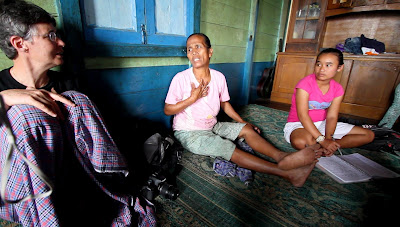The Pulang Kampung team met Ompu Sandra in 2013 when we moored at
Hasinggaan to show our film Rangsa ni Tonun and thus restore to the Batak
people in that isolated little bay a sacred and beautiful piece of Batak
literature about weaving. Ompu Sandra lived in the village next to the harbour.
 |
| This is the shore where our boat put in. Ompu Sandra lived in the house to the left with the blue trim around the bottom. |
Without knowing anything about her or the village, we knocked on her door to ask where there were weavers and to make an initial contact. We needed to find a place
to show our film.
It was bull’s eye immediately. Ompu Sandra turned out to be
a weaver and we were able to watch her carefully thread her weft through her
warp. Then she left her loom and made her house available for an impromptu film
showing. It was a small gathering but it was important for all of us because of
Ompu Sandra’s reaction. She wept as she watched the film.
 |
| Ompu Sandra was very moved by the film. |
 |
| She knew all the weaving techniques show in the film. |
I needed to know why she wept and I asked what it was that had touched her so deeply. She expressed admiration for her ancestors; was touched to see all of these processes in the film, processes that she had not seen for decades. “But why are you crying”, I asked, “if you are filled with admiration?” The cat gradually came out of the bag: because the work was so very arduous. She was empathizing with the weavers of the past. She was imagining how difficult and time-consuming all the processes of weaving had been, from spinning to dyeing to setting up the loom to finishing a textile. “Is it the hard work that makes you cry?” I asked in all innocence. But then the cat emerged fully. No, because there is no recompense for the effort expended!
 |
| Ompu Sandra was living the end of the Batak weaving arts and experiencing the pain of it. |
 |
| I gave Ompu Sandra a copy of Rangsa ni Tonun. We gave all of our hosts a copy so that they could refer to it after we were gone and share it. |
The screening of Rangsa ni Tonun with Ompu Sandra is not
something I can forget. Nor do I want to forget it. I later looked for a market
specifically for her but circumstances made it hard to get in touch
with her. I hoped that, when finally successful, I would not be too late and she would have stopped weaving altogether.
But I am too late. Ompu Sandra has stopped weaving forever. Lasma knows someone who hails from
Hasinggaan and thus she learned of Ompu Sandra’s death. She shared the news with me
on the telephone. We don’t know the circumstances of Ompu Sandra’s death. Given
my brief association with the elderly weaver, I have a dull, heavy sense that
she died of grief from the hardship of weaving fruitlessly. If it didn’t kill
her, this grief accompanied her to the grave. It is hard to know how to stop
mourning this fact, especially knowing that Ompu Sandra is not alone in
reaching the end of the market and the end of her tether at the same time as Batak
weaving, as the world has known it, also comes to an end.
We did as Ompu Sandra bid us to do: we showed Rangsa ni
Tonun again and again, to consumers, to government, to everybody who would pay
attention to it. All agree that it is a crime if the Batak weaving arts
disappear. Nobody knows exactly what to do to ameliorate the situation. Ompu
Sandra’s plea lives on, even if she does not. May she rest in peace.
(All photographs, except the first, are by MJA Nashir)

